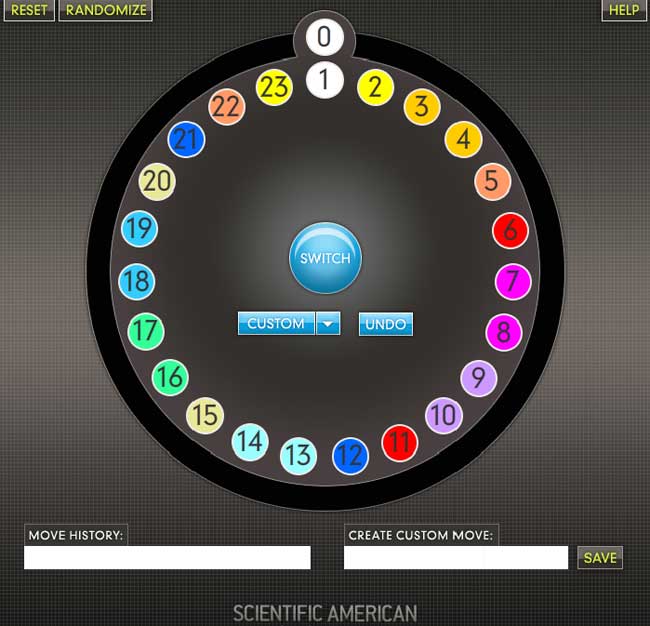
cube files
Indexed Cube Lovers Archive

|
cube archivesGAP filesBlogs
Forum topicsActive forum topics:New forum topics:User loginNavigation |
Diameter of the M24 Conway puzzle is 45
Submitted by Paul Timmons on Wed, 02/08/2023 - 11:21.

This is a well know puzzle in which there are two moves, one which rotates the central "clock" by one position clockwise or counter-clockwise. The other switches or swaps each pair of numbers with matching colours. I decided to plug these values into GAP to investigate God's number for the underlying group for this puzzle as it still seemed be unknown or undocumented anywhere at least. Feeding these numbers into GAP we get: S := (1,24)(2,23)(3,4)(5,22)(6,11)(7,8)(9,10)(12,21)(13,14)(15,20)(16,17)(18,19); R := (1,2,3,4,5,6,7,8,9,10,11,12,13,14,15,16,17,18,19,20,21,22,23); Note that we have the number 24 in place of 0 to be GAP compatible. Table: Distribution of word count in the Cayley graph for M24 Conway puzzle
Len Count
0 1 (the identity)
1 3 (R, R^-1 and S)
2 6 {R^2, R^-2, R*S, S*R, R^-1*S, S*R^-1}
3 10
4 16
5 26
6 42
7 68
8 110
9 178
10 288
11 466
12 752
13 1214
14 1958
15 3132
16 4980
17 7957
18 12738
19 20375
20 32563
21 52010
22 83000
23 132360
24 210896
25 335265
26 531855
27 842722
28 1332401
29 2098880
30 3291324
31 5121482
32 7872753
33 11885315
34 17455355
35 24565715
36 32401139
37 38652273
38 39596760
39 32213183
40 18556076
41 6407846
42 1041497
43 55472
44 577
45 1
So there is exactly one node requiring a manouevre of length 45 in the Cayley graph for the group generated by R and S assuming my results are correct. It would be nice to have independent verification of of the results in the table here (even up to a certain length). Expressed in term of the generators the single node w of length 45 is: w := R^3*S*R^-4*S*R^2*S*R^-1*S*R*S*R^-2*S*R*(R^2*S*R^-4*S)^2*R^2*S*R^-3*S*R*S; It is the permutation (2,19)(6,20)(7,16)(8,17)(11,15)(12,13)(14,21)(18,23). This differs from the original switch (S) in that 4 pairs of transpositions are omitted, and 8 remaining pairs of transpositions (colours) get swapped around (see diagram above to visualise). For the enthusiasts only! We may take in turn the group generated by w and R and we have a free of charge puzzle for the point stabiliser of M24 (namely M23) with the point 24 (or zero as originally put forward) omitted using the same diagram. This in turn has so-called God's number 32 with 11 nodes at the diameter - the odd one out of which is the involution R^3*w*(R*w*R)^2*R^4*(w*R^-1)^2*R^-1*w*R*(w*R^-1)^2*(w*R)^3*w Here is a snippet of the GAP code I used to preform the M24 Conway puzzle Cayley graph calculations: M24:=Group(S,R); w:=(2,19)(6,20)(7,16)(8,17)(11,15)(12,13)(14,21)(18,23); f:=Factorization(M24,w); /* Needed as this function can otherwise return suboptimal results */ arr:=[]; for i in [1..45] do; arr[i]:=0;od; n:=Iterator(M24); for i in [1..244823040] do; a:=NextIterator(n); f:=Factorization(M24,a); l:=Length(f); if l>0 then arr[l]:=arr[l]+1;fi; if Length(f) > 43 then Print(f, "-", Length(f),"-",i,"\n");fi;od; |
Browse archives
Pollwww.olympicube.com need cube lovers opinion on which cube to produce first olympic cube 6a 83% olympic cube 6b 17% Total votes: 23 Syndicate |
|||||||||||||||||||||||||||||||||||||||||||||||||